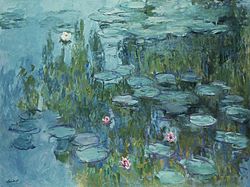Lekníny
| Lekníny | |
|---|---|
 | |
| Základní informace | |
| Původní název | The Water Lily Pond (The Japanese Footbridge) (series) |
| Autor | Claude Monet |
| Vznik | 1914 1899 |
| Typ | krajinomalba |
| Hnutí | impresionismus |
| Vlastnosti | |
| Šířka | 602 cm |
| Výška | 219 cm |
| Umístění | |
| Umístění | Francie |
| Některá data mohou pocházet z datové položky. | |
Lekníny (francouzsky Les Nymphéas) je název řady asi 250 obrazů hladiny rybníka s květy leknínů, kterou vytvořil francouzský malíř Claude Monet. Obrazy Monet maloval na zahradě svého domu v Giverny, který dnes patří nadaci Fondation Claude Monet. Řada Leknínů byla Monetovým hlavním uměleckým zájmem v posledních třiceti letech jeho života; mnohé z nich maloval ještě v době, kdy již byl vážně postižen šedým zákalem.[1][2] Zatímco raná díla série jsou poměrně realistická, pozdní Lekníny se stále více blíží abstraktnímu umění.
Lekníny jsou zastoupeny v řadě předních světových uměleckých institucí i v soukromých sbírkách. Dvanáct pláten podélného formátu, které Monet věnoval v roce 1923 státu, je vystaveno v pařížském Muzeu Oranžérie, kde pro ně byly vybudovány dva oválné sály. [3] V červnu 2014 se jeden z obrazů této řady vydražil v Londýně u firmy Sotheby's za 54 milionů amerických dolarů.[4]
Galerie
- Lekníny, 1920–1926, Musée de l'Orangerie
- Rybník s lekníny, asi 1915–1926, Chichu Art Museum, Naošima, Japonsko
- Vistárie, 1925, Gemeentemuseum Den Haag
- Lekníny, 1922, Toledo Museum of Art
- Rybník s lekníny, 1919, soukromá sbírka
- Lekníny, 1919, Metropolitan Museum of Art, New York City
- Rybník s lekníny, asi 1917–1919, Albertina
- Lekníny, 1917–1919, Honolulu Museum of Art
- Rybník s lekníny a vrba, 1916–1919, soukromá sbírka
- Nymphéas reflets de saule, 1916–1919, Musée Marmottan Monet
- Modré lekníny, 1916–1919, Musée d'Orsay
- Lekníny (Žlutá nírvána), po r. 1916, National Gallery, London[5]
- Lekníny, 1916, Musée Marmottan Monet
- Lekníny, 1916, National Museum of Western Art, Tokyo[6]
- Bílé a žluté lekníny, 1915–1917, Kunstmuseum Winterthur, Winterthur
- Lekníny, 1915, Musée Marmottan Monet
- Lekníny, 1914–1917, National Gallery of Australia
- Lekníny, 1914–1917, Toledské umělecké muzeum
- Lekníny, 1915, Neue Pinakothek, Mnichov
- Lekníny, 1908, Tokyo Fuji Art Museum
- Rybník s lekníny, 1908, soukromá sbírka
- Lekníny, 1907 The Museum of Fine Arts, Houston
- Lekníny, 1907, Bridgestone Museum of Art, Tokyo
- Rybník s lekníny, 1907, Israel Museum
- Lekníny, 1906, Art Institute of Chicago
- Lekníny, 1905, Museum of Fine Arts, Boston
- Rybník s lekníny, 1904, Denver Art Museum
- Lekníny, 1904, soukromá sbírka
- Lekníny, 1903, Dayton Art Institute, Dayton
- Rybník s lekníny, detail, 1899, Boston Museum of Fine Arts
- Lekníny, 1897–1899, Galleria Nazionale d'Arte Moderna
- Lekníny, 1897–98, Los Angeles County Museum of Art
- Lekníny a japonský můstek, 1897–1899, Princeton University Art Museum
Odkazy
Reference
- ↑ "Monet, Claude." Grove Art Online.
- ↑ SMART, Alastair. Why are Monet's water-lilies so popular? [online]. telegraph.co.uk, 18 October 2014 [cit. 2016-11-02]. Dostupné online.
- ↑ KRSEK, Ivo. Claude Monet. Praha: Odeon, 1982. S. 74.
- ↑ http://www.latimes.com/entertainment/arts/culture/la-et-cm-monet-painting-auction-20140626-story.html
- ↑ Archivovaná kopie. www.nationalgallery.org.uk [online]. [cit. 2019-02-03]. Dostupné v archivu pořízeném dne 2012-01-13.
- ↑ Archivovaná kopie. collection.nmwa.go.jp [online]. [cit. 2019-02-03]. Dostupné v archivu pořízeném z originálu.
Literatura
- HOSACK JAMESOVÁ, Karen. Slavné obrazy. Praha: Euromedia Group a.s., 2019. Kapitola Jezírko s lekníny, s. 186–189.
Externí odkazy
 Obrázky, zvuky či videa k tématu Lekníny na Wikimedia Commons
Obrázky, zvuky či videa k tématu Lekníny na Wikimedia Commons
Média použitá na této stránce
"Water-Lily Pond"
Autor: Rufus46, Licence: CC BY-SA 3.0
| Claude Monet (1840–1926) |
|||
|---|---|---|---|
 |
|||
| Pseudonym |
Oscar-Claude Monet | ||
| Popis | francouzský malíř a grafik | ||
| Datum narození / úmrtí |
14. listopadu 1840 |
5. prosince 1926 | |
| Místo narození / úmrtí |
Paříž |
Giverny | |
| Období tvorby | impresionismus | ||
| Místo tvorby | |||
| Soubor autorit | |||
Seerosen, um 1915
| Nová pinakotéka
|
|||
|---|---|---|---|
 |
|||
| Nativní název | Neue Pinakothek | ||
| Nadřazená instituce | Bayerische Staatsgemäldesammlungen | ||
| Poloha | |||
| Souřadnice | 48° 08′ 59″ s. š., 11° 34′ 16″ v. d. | ||
| Založeno | 1853 | ||
| Internetová stránka | www.pinakothek.de | ||
| Soubor autorit | |||
A high resolution scan of The Water-Lily Pond hosted on the Google Arts & Culture page
Seerosenteich, Spiegelung von Trauerweiden
Öl auf Leinwand 155 x 131 cm
Painting in the Kunstmuseum Den Haag
Autor: Claude Monet, Licence: CC BY-SA 2.5
Claude Monet (French, 1840–1926)
Water Lilies, 1919
Oil on canvas; 39 3/4 x 78 3/4 in. (101 x 200 cm)
The Metropolitan Museum of Art, New York, The Walter H. and Leonore Annenberg Collection, Gift of Walter H. and Leonore Annenberg, 1998, Bequest of Walter H. Annenberg, 2002 (1998.325.2)
View at the Metropolitan Museum of Art website
This photo of item # 1998.325.2 at the Metropolitan Museum of Art was contributed under the team name "shooting_brooklyn" as part of the Wikipedia Loves Art project in February 2009.
Metropolitan Museum of Art











![Lekníny (Žlutá nírvána), po r. 1916, National Gallery, London[5]](http://upload.wikimedia.org/wikipedia/commons/thumb/5/50/Claude_Monet_044.jpg/250px-Claude_Monet_044.jpg)

![Lekníny, 1916, National Museum of Western Art, Tokyo[6]](http://upload.wikimedia.org/wikipedia/commons/thumb/5/5d/Monet_Water_Lilies_1916.jpg/250px-Monet_Water_Lilies_1916.jpg)




















































